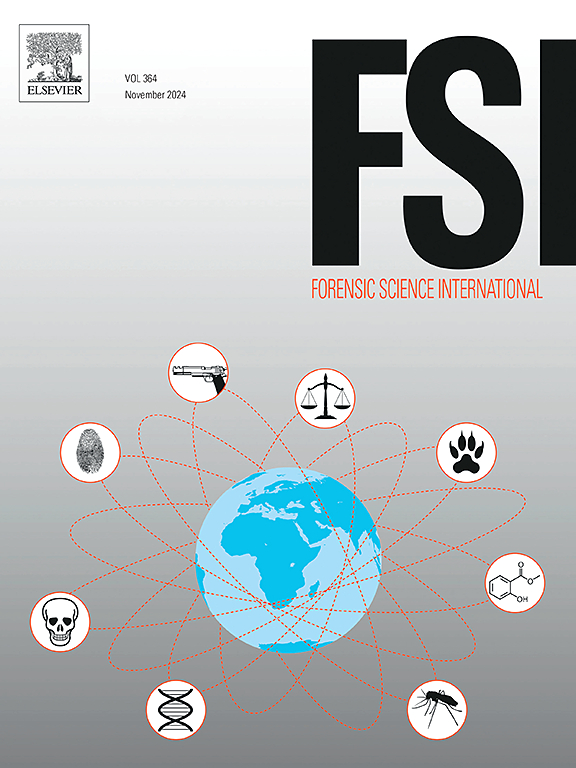非法毒品贩运中的DNA证据:包装材料间转移DNA的法医分析
IF 2.2
3区 医学
Q1 MEDICINE, LEGAL
引用次数: 0
摘要
非法药物的分销途径通常涉及粉末状物质,并通过多个中介将其封装在小塑料袋中分发。本研究通过两种实验途径研究了参与这些材料的生产、包装和运输的个体之间的DNA转移动力学。在第一个实验设计中,我们建立了一个两人链,参与者a制造胶囊并将其包装成拉链锁袋(ZLBs),随后由参与者C运输,为期四天。第二个实验路径涉及一个三人链:参与者a准备胶囊,参与者B将胶囊插入zlb中,参与者C携带包裹。在多个表面进行DNA采样:zlb的内部、半保护的开口区域、外表面、胶囊外表面和储存容器。法医分析采用Verifiler™Plus进行DNA分析,随后使用STRmix™软件进行数据反卷积。结果表明,尽管可观察到的DNA在胶囊、储存容器和袋子内部转移,但从胶囊中可以成功地恢复信息丰富的DNA图谱。zlb的外表面产生了复杂的混合轮廓,而更受保护的表面——袋子内部和胶囊外部——通常产生的轮廓主要是一个或两个贡献者。这些发现对法医调查策略具有重要意义,表明以包装材料的内部表面和胶囊的外部为目标,可以更可靠地识别参与药物包装初始阶段的个人,而外部表面可以更深入地了解分销链中最近的处理事件。本文章由计算机程序翻译,如有差异,请以英文原文为准。
DNA evidence in illicit drug trafficking: A forensic analysis of transfer DNA between packaging materials
The illicit drug distribution pathway commonly involves powdered substances encapsulated and distributed in small plastic bags via multiple intermediaries. This study investigated the DNA transfer dynamics between individuals involved in the production, packaging, and transportation of such materials through two experimental pathways. In the first experimental design, we established a two-person chain wherein Participant A manufactured and packaged capsules into zip lock bags (ZLBs), which were subsequently transported by Participant C for a four-day period. The second experimental pathway involved a three-person chain: Participant A prepared the capsules, Participant B inserted them into ZLBs, and Participant C carried the packages. DNA sampling was conducted on multiple surfaces: the interior of the ZLBs, the semi-protected opening regions, the exterior surfaces, the capsule exteriors, and the storage containers. Forensic analysis employed Verifiler™ Plus for DNA profiling with subsequent data deconvolution using STRmix™ software. Results demonstrated that informative DNA profiles could be successfully recovered from capsules despite observable DNA transfer between capsules, storage containers, and bag interiors. The exterior surfaces of ZLBs yielded complex mixed profiles, whereas the more protected surfaces—bag interiors and capsule exteriors—typically produced profiles with predominantly one or two contributors. These findings have significant implications for forensic investigation strategies, suggesting that targeting the interior surfaces of packaging materials and capsule exteriors may provide more reliable identification of individuals involved in the initial stages of drug packaging, while exterior surfaces offer greater insight into recent handling events in the distribution chain.
求助全文
通过发布文献求助,成功后即可免费获取论文全文。
去求助
来源期刊

Forensic science international
医学-医学:法
CiteScore
5.00
自引率
9.10%
发文量
285
审稿时长
49 days
期刊介绍:
Forensic Science International is the flagship journal in the prestigious Forensic Science International family, publishing the most innovative, cutting-edge, and influential contributions across the forensic sciences. Fields include: forensic pathology and histochemistry, chemistry, biochemistry and toxicology, biology, serology, odontology, psychiatry, anthropology, digital forensics, the physical sciences, firearms, and document examination, as well as investigations of value to public health in its broadest sense, and the important marginal area where science and medicine interact with the law.
The journal publishes:
Case Reports
Commentaries
Letters to the Editor
Original Research Papers (Regular Papers)
Rapid Communications
Review Articles
Technical Notes.
 求助内容:
求助内容: 应助结果提醒方式:
应助结果提醒方式:


